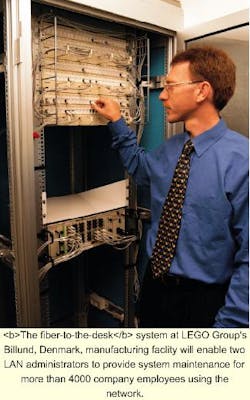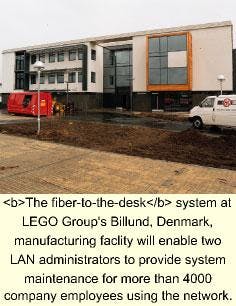High-profile projects pace desktop fiber outside of the United States
When 3M (Minneapolis, MN) announced at this year's Networld+Interop in Las Vegas the deployment of its Volition Fiber-to-the-Desktop Cabling System in China, the news highlighted a growing trend in horizontal fiber applications. The Great Hall of the People, site of the new installation, is China's equivalent to the U.S. House of Representatives. The project was not a new build, but the renovation of a cultural landmark.
3M has also installed similar fiber solutions at the Lego Group in Denmark, Pirel* Tyre Research Center Europe in Italy, Cadbury Ltd. in France, and the Guinness Brewery in London. Several European universities are also adopting the company's fiber-to-the-desk systems, including the University of Hamburg, Germany, and University of Milan, Italy. Why does fiber appear to be a more popular medium in areas outside North America when it comes to desktop solutions-even when the application doesn't include new builds?
In North America, fiber-to-the-desk solutions still face many obstacles, despite a hard push by several influential groups of fiber proponents. For example, the requirements of most local area networks (LANs) can still be supported with existing copper infrastructures for the foreseeable future, say observers. The total cost of fiber versus copper to the PC continues to favor the use of legacy copper systems as well.But in other parts of the world, the situation and rules are different. Germany and its Nordic neighbors, for example, may be considered the "hub" for the move to fiber-to-the-desk. Unlike in the United States, shielded twisted-pair and foil twisted-pair have been the industry standard for LAN cabling-and the prices are high. Therefore, these high prices make an affordable fiber networking solution a more attractive choice in much of Europe. Customers in the region view fiber as a better value than copper cabling.
"Another reason for the acceptance of fiber cabling for the LAN in many parts of the world is concern about electromagnetic interference [EMI]," says John Riccardi, global business manager for 3M's Volition Networking System. "Much of Europe has very strong EMI regulations, and since fiber is immune to such interference, it is a natural solution."
Space is also more of a challenge in other areas of the world. Many of the buildings where LANs are currently being installed were not originally designed to accommodate large networking systems. "There is no room for duct work and little room for telecommunications closets," says Riccardi. "Fiber is able to carry more bandwidth in smaller spaces and eliminate the need for closets. Copper cannot."
These and other fiber drivers that exist in Europe have enabled faster acceptance of fiber-to-the-desk architectures when compared to the United States, where copper still maintains a dominant foothold in the LAN market. For instance, the Lego Group, one of the world's largest toy manufacturers, chose to pursue an all-fiber network as early as 1992. More than 4000 fiber-optic outlets were installed. In August 1998, Lego installed trial lines using the Volition product line in one building, eventually opting for the system in other buildings. One of the Lego manufacturing facilities covers 1.5 km, giving fiber the nod over copper for its ability to exceed the distance limitations inherent in copper."Many organizations in other parts of the world are simply selecting fiber cabling because it is the best solution for their needs," says Riccardi. "I think they compare the affordability factor of new fiber solutions, and they also examine the way fiber can help solve many of the common networking problems. That is how the fiber-to-the-desk solution, instead of copper, has started to proliferate."
Riccardi believes Germany is the prime example of a country far ahead in the use of fiber-optic technology-as much as five years ahead in the deployment of fiber. "In fact, the government has made use of fiber optics a standard in all cabling projects," says Riccardi. "Also, with the integration of East Germany, there is a lot of upgrade activity going on."
Although not everyone may agree with Riccardi's perception that the United States lags behind other parts of the world in fiber-to-the-desk applications, it is clear that other parts of the world have some unique drivers that make fiber a more advantageous medium in many situations. Whatever the reasons, if fiber-to-the-desk becomes the trend in some parts of the world, LAN systems everywhere will feel the pressure of customer demand to "keep up with the Joneses." q

